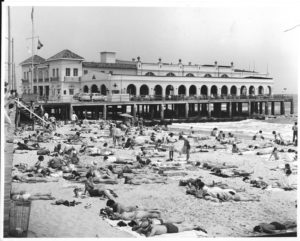
By Harlan B. Radford, Jr.
The origins of today’s Ocean City Music Pier emerged from the ruins of a catastrophic fire that occurred on October 11, 1927, and destroyed a large part of the boardwalk along with some homes and many business establishments, including the elegant Hotel Normandie, the Hippodrome Amusement Pier, the Traymore Hotel and the Colonial Theatre.
While the actual cause of the fire was never determined, more than 400 firefighters from numerous communities in the area were called in to fight Ocean City’s Great Fire of 1927. Fortunately, there was no loss of life.

By the spring of 1928, a major project began with re-constructing the Ocean City boardwalk between 6th and 12th Streets.
An important part of that construction project included building a grand concert hall that would originally be christened the Municipal Pavilion in 1928, actually undergo construction in 1928-29, and soon thereafter became popularly known as the Music Pier and provided live entertainment for the public. Mayor Joseph Champion was instrumental in dedicating this new facility and before long, the Music Pier was the site of frequent conventions, bazaars, dances, and daily free summer concerts.

As one of the most iconic buildings in the seashore resort, this distinctive structure with its oceanside location at Moorlyn Terrace and the Boardwalk reflects the architectural style of the Spanish Revival period.
Two days after the December 7, 1941 attack on Pearl Harbor, Ocean City’s Daily Sentinel-Ledger reported a lookout tower was to be built on the top of the Music Pier. Its sole purpose was to provide a means of coastal defense as a “look-out” point for protecting a portion of the Jersey seaboard from enemy submarines or U-boats in the water as well as enemy aircraft in the skies. Kelly Tjoumakaris, wrote of it in “Making Music,” which appeared in Ocean City, NJ Magazine in August 2013 (p47):
In the immediate wake of the Pearl Harbor tragedy, December 1941, the first structure in the country built especially for aircraft spotters was erected atop the Music Pier. Volunteers consisting of teenage boys from Ocean City High School to retired residents from the island kept watch 24 hours a day.
The observation tower was operated and manned 24 hours every day of the year and played a vital role in the war effort from 1942 to the end of the war in 1945. It appears the American Legion was responsible for most of the recruitment as well as the scheduling of the plane and sub spotters. It took considerable effort to establish a network of civilian observers and to train them to be able to recognize and differentiate all types of aircraft.
According to one source, Ocean City’s 147 spotters were comprised of some high school-aged youth and many adult volunteers including some retired persons. These spotters are said to have spent two hours a week observing and reporting all aircraft activity along the Ocean City shoreline. In his 1999 book, Ocean City, NJ by Arcadia Publishing, p87, Mark McLaughlin wrote, “…there were a few U-boat sightings and that one was actually captured by the Coast Guard north near Atlantic City.”

The civilian volunteers who were trained to act as airplane spotters were organized as a unit of the Aircraft Warning Service. The rare article at left mentions the Music Pier observation tower and praises the high-efficiency rating of the tower.

The little-known tower with its observation windows can easily be seen on the Music Pier roof in most of the preceding postcard images. The tower remained in place until 1968 when it was dismantled.
The next time you should happen to venture to the Jersey Shore and visit Ocean City and the popular Music Pier on the boardwalk, think about the brief but nevertheless important role this building played in our history.
In observance of Pearl Harbor Day 2016, Ocean City Magazine published “December 7, 1941 – A Day That Will Live in Infamy!” by Fred Miller. The article describes other ways in which the barrier island community mobilized civil and government resources to defend itself from attack.
Few people today know of the vital role that Jersey Shore towns played in America’s defense during World War II. John DeRosier, Staff Writer for The Press of Atlantic City, wrote “How a German submarine attack forever changed Cape May” in 2017.
We look forward to readers’ comments and recollections on the topic.
Your message has been sent
Jan. 25, 2021, William Thorpe writes: I have very fond memories of singing with the Ocean City Pops on the Music Pier in the 1980s and 90s, but had never heard about the watch tower. It was gone by the time I sang there. What an interesting story about the important role it played at a time when the entire country was united against a common enemy! I wish I had known that history when I sang WWII-era Cole Porter songs there. I’m very happy to see that the building is still there. Thanks for this story.

Very cool John. Happy New Year
My grandfather, Irving Mounts, was a volunteer in the tower. I remember a story my mother told me of a time my grandfather reported to the power for his watch and found the previous volunteer had died from injuries sustained from falling down the stairs leading to the tower. So sad.